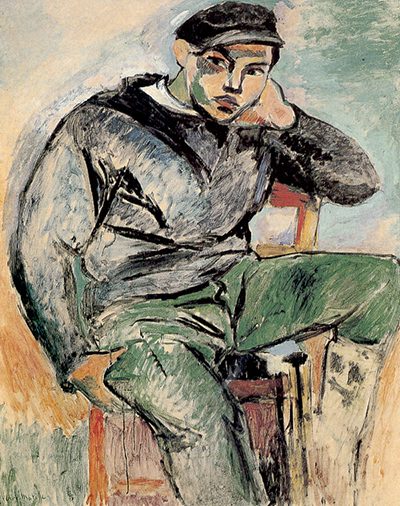Matisse adored the coastal retreat of Collioure and produced a number of drawings and paintings here over a period of several summers in the first decade of the 20th century. Here is one of a number of sailor portraits that was part of his work here.
The young sailor, Germain Augustin Barthélémy Montargès, initially caught Matisse's eye in 1905 upon his first visit and they would work together several times. Fishing was a key element to the industry and culture of this region and Matisse wanted to capture that during his summers holidaying here. He also saw an immediate look in this young man that he felt would be well suited to his work. The artist would continue to return to Collioure for around a decade, almost every year in fact. This part of France had already held a long history in inspriring leading literary figures both from France and also the UK, some of whom would actually choose to relocate here permanently. The portrait within both sailor portraits feature a near identical pose, but with different artistic styles.
This painting was actually produced in the following year, 1906, and with a follow up titled The Young Sailor II. This first version has a rougher finish, where colours are shaded in but not completed into whole solid forms. Most of the detail is suggested at, rather than being fully completed. This approach was deliberate but in the second version he chose to define everything more clearly. It may have been that this first approach was more experimental, seeking to understand how best to portray this young man. He perhaps started with the strong lines of black to create outlines and form, before then loosely adding in the shades of colour. This style feels expressive, as if capturing the essence of the scene but without concerning oneself with every precise element of the composition.
This piece is dated 1906 and believed to be in a private collection, but much less is known about it than the follow up piece of the same year. We see a development in the artist's style from one to the other, moving towards solid blocks of colour rather than the approximate strokes found here which are not fully formed. We see the background showing through and this rough sketching style is continued across the background, with tones of orange, blue and green used to decorate the area behind the sitter. Even his boots are left unfinished, as is the chair on which he sits. That said, the facial elements are fully formed, certainly, with a memorable expression from this young man which perhaps may have taken some guidance from Matisse if this was his first sitting. He looks serious, but his pose is relaxed, with his right hand on his leg, as he leans on his other.




